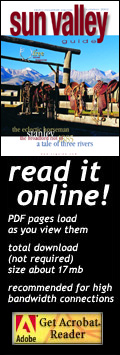| click here for the |
| front page |
| features |
| stanley, idaho |
| bronc riding |
| broadford riot 1885 |
| fighting fires |
| arts |
| three jewelers |
| custom saddles |
| living |
| kitchen design |
| pilates |
| recreation |
| white water fun |
| sporting clays |
| names of the peaks |
| summer trails |
| summer a to z |
| dining |
| seafood in the mtns |
| calendar |
| summer 2002 |
| listings |
| galleries |
| outfitters & guides |
| fitness |
| tennis |
| golf |
| property mgmnt. |
| lodging |
| dining |
| maps |
| ketchum+sun valley |
| summer trails |
| KART bus map |
| the guide |
| last winter |
| advertising |
| about us |
| copyright |
| Copyright
© 2002 Express Publishing Inc. All Rights reserved. Reproduction in whole or in part in any form or medium without express written permission of Express Publishing Inc. is strictly prohibited. |
| Produced
& Maintained by Express Publishing, Box 1013, Ketchum, ID 83340-1013 208.726.0719 Voice 208.726.2329 Fax info@svguide.com |
| The Sun Valley Guide is distributed free twice yearly to residents and guests throughout the Sun Valley, Idaho resort area communities. Subscribers to the Idaho Mountain Express will receive the Sun Valley Guide inserted into the paid edition of the newspaper. |

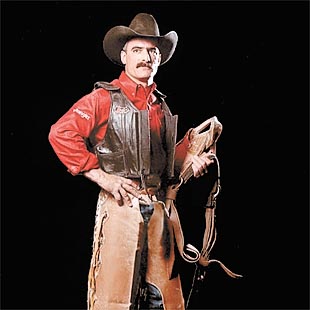
The
Eclectic Horseman
Bronc
buster Kelly Wardell of Bellevue
by Jody Zarkos
It is every professional rodeo cowboy’s goal to make it to the National Finals Rodeo in Las Vegas in December, and it’s every cowboy’s dream to win the world championship of his sport at the NFR.
Only the top 15 money earners of the year are invited to the championship.
Kelly Wardell, an eight-year resident of Bellevue, Idaho, has been to the NFR four times in his 18-year career, but has never taken home the coveted gold buckle as world champion.
Will this be his year? I caught up with Wardell at his home in Bellevue and played 21 (questions) with the man who gambles it all on the back of a bucking horse.
SVG—Can you actually stay on a horse longer than eight seconds?
KW—Oh yeah. My dad raised racehorses. I broke all his racehorses and galloped them.
SVG—How did you get into bareback riding?
KW—My dad did it, and I wanted to do it from the time I was a little kid. My whole family tried to talk me out of it. Some of them still think I should get another job.
SVG—What would you be doing if you were not a bareback rider?
KW—I guess I have thought about that. I am an adrenaline junkie. So, I would probably race snowmobiles or motorcycles. I will always love horses, but I could see doing that.
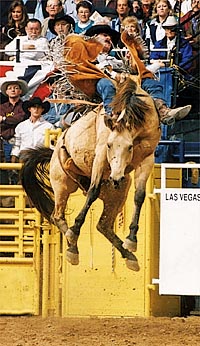 SVG—Is there one job you would never do?
SVG—Is there one job you would never do?
KW—Sitting in an office behind a desk would drive me crazy. I love being outside and doing stuff with my hands, welding and building things. I am not an inside guy.
SVG—What is the worst thing that has ever happened to you bareback riding?
KW—In 1999 in Pleasant Grove, Utah, a horse rolled in the air and landed on top of me. My shoulder dislocated and went out toward my back. It tore the rotator cuff and tendons off the bone. I was at the same rodeo the next year and drew the same horse, Charlie’s Girl. It was a defining moment in my career, because I went and got on her and I didn’t want to. I felt like I stared adversity in the face. Afterward, I felt, heck, I can do anything.
SVG—Do you think cowboys, especially rough stock riders, are crazy?
KW—No, I don’t think they are crazy. I think they are tough. I have good friends who are veterinarians and still rodeo.
SVG—How long does it take you to get out of bed in the morning?
KW—Ask me when I am 50. Actually, not that long. I am in good shape and I have been on nutrition products that have helped me a lot in the last few years.
SVG—When you make a good ride, what does it feel like?
KW—It’s like nothing else. There is no drug that can describe the feeling you get when you make an awesome ride and the crowd is yelling. It’s a high like no other and can last for days. When I scored 91 points in Las Vegas and won the tour finals (in 2001) it lasted quite awhile. Last year, I was leading the world, and we (Kelly and traveling partner and current world champion bareback rider Lan LaJeunesse) went to nine rodeos in seven days and we were never under 80 points. Everywhere we went we were first and second. We each won almost $20,000 that week. It was unreal.
SVG—Many people may not know that there was an Olympic Command Performance Rodeo held during the 2002 Winter Olympics. What was it like competing and winning the silver medal for bareback riding there?
KW—That was awesome standing up there on that podium. It was one of the highlights, if not the highlight of my career. When they played the anthem, well, that was pretty cool.
SVG—Who are your heroes and why?
KW—Joe Alexander. He was a five-time world champion bareback rider in the ’70s. He’s from Wyoming like me. Him and my dad rodeoed some together. He is just one of the greatest bareback riders ever. He was always in control and always seemed to do it right. My traveling partner, Lan, is one bareback rider I am always in awe of. If he draws a horse that bucks, it is almost impossible to beat him. He is the mentally toughest athlete I have ever been around, and the mental game is 99 percent of what we do.
SVG—What is the nicest thing anyone has ever done for you?
KW—So many nice things have been done for me I can’t even imagine. Winning the Coors Fans Favorite Cowboys award in 1997 was pretty neat. It was a great feeling knowing that you had the respect of the fans out there and that they were watching and paying attention to who is riding and how they act around people. It’s the fans who make our sport.
SVG—Are you a role model?
KW—I would like to think so. I think I am morally and how I act around kids. I like helping kids. I taught a bareback school at the College of Southern Idaho when I was riding in Pocatello. I drove back and forth. I would like to have a camp for kids when I am done rodeoing and teach bareback riding.
SVG—What do you like about living in the Wood River Valley?
KW—It’s beautiful country, and I can fish and hunt. I love the snow. It’s a perfect place for me.
SVG—Do you have any extravagances?
KW—I can’t afford ’em.
SVG—If they were going to make a movie about your life, what would the title be and who would star in it?
KW—Blood, sweat and tears. Sam Elliot.
SVG—Have you ever come close to quitting?
KW—Several times. I have been hurt bad enough that I have thought about it, but never reaching my goal kept me from quitting. My first goal was to qualify for the NFR, and it took me a long time and every penny I made to do that.
SVG—How many bucking horses do you think you have been on in your lifetime?
KW—Probably about 3,500. I average about 150 a year, and when I was just starting out it was about 200 a year.
SVG—Is the sport of rodeo dying?
KW—No, it’s just changing. The agriculture industry is dying. We aren’t getting kids from farms and ranches anymore. We’re getting them from town. Fellowship and camaraderie are the greatest part of rodeo, but a lot of new kids don’t understand it.
SVG—What is Kelly Wardell going to be doing 10 years from now?
KW—I hope I am still teaching kids about rodeo. I hope to have my rodeo camp going year-round. I want to stay involved.
SVG—What are your goals for this year?
KW—This year I am starting out slow. I figure I am going to end fast. Last year I led the standings from the beginning and then I fizzled out. This year I want to end with a bang. I want to get that gold buckle I didn’t get last year. I have to look at it every time I pick Lan up.
SVG—If you had to be reincarnated, what would you come back as and why?
KW—I would be a bucking horse. They are really well taken care of. I would like to see how hard I could buck and how tough the cowboys really are. Plus, I have been on the receiving end so long it would be nice to be on the giving end.
•
sidebar:
Mud,
Sweat and Steers
The buck
starts here: all you need to know about rodeo
By Jody Zarkos
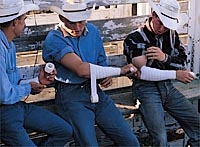 Many of today’s rodeo events trace their roots directly back to the days of the Old West. Horses had to be broken, cows had to be caught and doctored. Ranch hands would gather and compete among themselves to see who had the best riding style on an unbroken horse or who could rope a steer the fastest. Today’s rodeos are a little slicker and quicker, but it’s still man or woman against beast in a cloud of dust.
Many of today’s rodeo events trace their roots directly back to the days of the Old West. Horses had to be broken, cows had to be caught and doctored. Ranch hands would gather and compete among themselves to see who had the best riding style on an unbroken horse or who could rope a steer the fastest. Today’s rodeos are a little slicker and quicker, but it’s still man or woman against beast in a cloud of dust.
The Days of the Old West Rodeo in Hailey, one of the most cherished events in the Wood River Valley and now a PRCA sanctioned rodeo, is one of the most traditional ways to celebrate the quintessential American holiday, the Fourth of July.
But if you don’t know your riggings from your Wranglers, here is a primer for you.
ROUGH STOCK EVENTS
Saddle Bronc
Saddle Bronc is considered rodeo’s “classic event,” as it traces its history directly back to the halcyon days of the Old West.
The horse and rider start out in the rodeo chute. When the gate opens, the cowboy’s spurs must be over the horse’s shoulders to give the horse an advantage. Cowboys hold onto a rope attached to the horse’s halter, called a bronc rein. Riders are scored on spurring—long spurring strokes are best—control and how the horse bucks.
The cowboy is disqualified if he touches the animal, himself or equipment with his free hand before the eight-second buzzer, if either foot slips out of a stirrup, or if he fails to “mark out” (have his feet in proper position at the start of the ride.
A pair of judges award 0 to 25 points to both horse and rider. The highest score ever awarded on the Professional Rodeo Cowboys Association tour is 95 points to Glen O’Neill on Skoal’s Airwolf in 1996.
Bareback Riding
You want wild? Check out bareback riding, which consistently produces some of the best action in the arena.
Bareback is similar to saddle bronc in that a rider must “mark out” his mount and cannot touch the animal with his free hand.
Instead of a saddle, bareback riders use rigging that is a handhold made of leather and rawhide attached to a cinch around the horse’s belly.
Contestants spur from shoulders to rigging and must stay on for eight seconds. The world record in bareback riding is 93 points by Joe Alexander on Marlboro in 1974.
The horse’s performance accounts for half the cowboy’s score.
Bull Riding
It’s not often a man will give up 1,000 pounds to an opponent, but maybe that’s why cowboys are a breed apart.
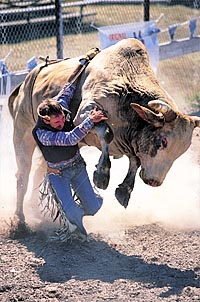 Man against bull. The object: stay on, and be sure to get out of the bull’s way when you get off.
Man against bull. The object: stay on, and be sure to get out of the bull’s way when you get off.
Strength, control and heart are all prerequisites of bull riders who try to stay on a ton of mad hamburger for eight seconds.
A cowboy must position himself for every turn, jump, spin and twist.
Riders are judged on good body position, use of the free arm and spurring action, which is not required, but will add points to a rider’s score.
World record holder Wade Leslie was judged to have a perfect ride in 1991, scoring 100 points on Wolfman.
TIMED EVENTS
Team roping
Team roping is a dance between two partners, and the header leads.
The header is the cowboy who ropes the steer first. The header charges out of the box and must lasso the steer around its head or horns. The header then steers the animal to the left to give his partner, the heeler, a clean shot at the steer’s hind feet.
If a heeler tosses his loop before the header has changed the direction of the steer and has the animal moving forward, it is called a “crossfire,” and the riders are disqualified.
The run is completed when the steer is secured and the ropers’ horses are facing each other on opposite sides of the steer.
As in any timed event, the riders are penalized 10 seconds if the header breaks the barrier—a line across the starting box—before the steer. A cowboy is also penalized five seconds for only roping one foot.
Although arena conditions and sizes may vary, the PRCA record is 3.5 seconds by Blaine Linaweaver and Jory Levy in 1986 in San Antonio, Texas.
Calf Roping
The American cowboy began calf roping out of necessity. Calves had to be roped and tied down for medical treatment or to be branded. Calf roping is one of rodeo’s oldest events.
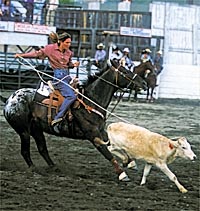 In rodeo, the calf bursts out of a chute, and horse and rider give chase. The cowboy ropes the calf around the head and must dismount his horse, run to the calf, flip it on its side and tie up any three of its legs using a “pigging string” he carries in his teeth.
In rodeo, the calf bursts out of a chute, and horse and rider give chase. The cowboy ropes the calf around the head and must dismount his horse, run to the calf, flip it on its side and tie up any three of its legs using a “pigging string” he carries in his teeth.
When the cowboy completes his tie, he throws his hands up in the air to signal to the judge.
The cowboy must get back on his horse and allow the rope to become slack. The run is declared invalid if the calf kicks free within six seconds.
Again, a 10-second penalty is added if the calf roper breaks the barrier before the calf.
Lee Phillips set the PRCA world record of 5.7 seconds without leaving the box.
Steer Wrestling
Bulldogging, as it’s also called, is known as a “big man’s” event, with good reason. A man has to jump from a galloping horse onto a steer’s back and wrestle it to the ground.
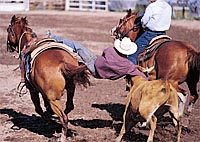 At more than 600 pounds the steers don’t go down easily, but a strong cowboy with a good technique will make it look that way using leverage and momentum.
At more than 600 pounds the steers don’t go down easily, but a strong cowboy with a good technique will make it look that way using leverage and momentum.
The bulldogger starts out on horseback and gallops after the steer. Another rider, or “hazer,” keeps the steer traveling in a straight line until the competitor pulls even with the steer.
When the cowboy is abreast of the steer, he eases down the right side of his horse, wraps his arms around the steer’s horns, dismounts and digs his heels into the dirt to slow down the steer.
As the steer halts, the cowboy turns the animal and tries to push him down to the ground. The clock stops when the steer is on its side with all four legs pointing in the same direction.
Four men, Jim Bynum, Todd Whatley, Gene Melton and Carl Deaton are tied for the world record of 2.4 seconds.
Barrel Racing
You have to be an all-around great horsewoman to be a successful barrel racer, which combines horsemanship, pageantry and conditioning.
In barrel racing, the contestants enter the arena at full speed. The rider guides her horse in a cloverleaf pattern around three barrels set an equal distance apart in the arena. An electronic eye is triggered at the start and finish of the pattern.
The contestant can touch or even move the barrels, but if she knocks one over she is given a five-second penalty. •
